Archive for the ‘Cyanotypes’ Category
HILL END ANALOGUE: Our Cyanotype Works
We are excited to announce that a selection of our Cyaanotype artists books was presented at the Hill End Analogue event.
.
HERE’S THE BACK STORY
Hill End Analogue ( HEA ) is an analogue photographic arts festival presented by Hill End Arts Council Inc. ( HEAC ) in the Central West township of Hill End, N.S.W. HEA
showcased and connected contemporary analogue photographic artists world-wide. The event comprised exhibitions and workshops, the festival engaged with the general community, while promoting contemporary analogue arts and technology.
Hill End is an historic site, managed by N.S.W. National Parks Wildlife Service, and is significant in the history of Australian Photography. The documentation of Hill End and surrounds during the gold boom of the 1870’s by Beaufoy Merlin and Charles Bayliss, forms a large part of the Holtermann Collection in the N.S.W. State Library. Hill End has a thriving arts community, supported by the Bathurst Regional Art Gallery and is closely associated with the National Art School.
(Text modified from the HEA website)
.
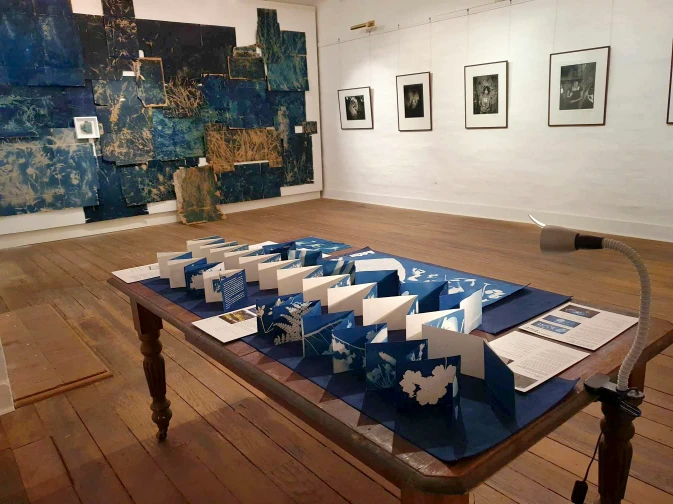
Hill End Analogue Installation PHOTO: Courtesy of Lisa Sharkey
.
OUR CYANOTYPES
.
MORE INFORMATION ON THESE CYANOTYPE WORKS
.
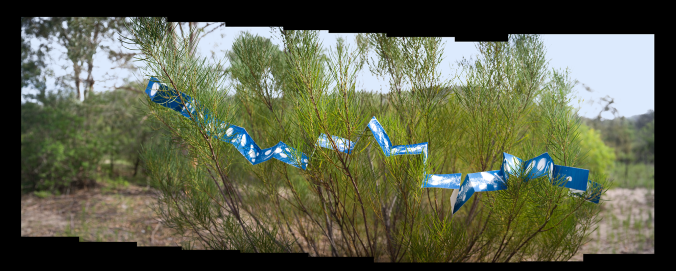
Victoria Cooper’s “Flood” in situ on the island Bundanon
.
FLOOD An artists book by Victoria Cooper
MEDIA: Concertina format with 26 pages, cyanotype on Arches watercolour paper with hand-set type in black ink
Binding by Doug Spowart
SIZE: 10 x 15 x 3cm cm
EDITION: Two unique states
Download a didactic about this book: COOPER – Flood installation at Bundanon
.
.
.
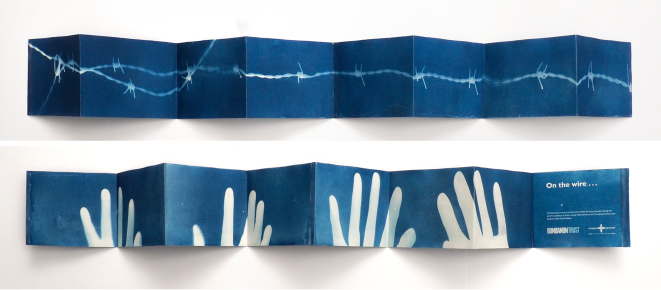
On the wire … A book by Doug Spowart
.
ON THE WIRE … A book by Doug Spowart
A performance based on open-air cyanotype bookmaking directly off subjects in the field.
CREATED: 2007 at Bundanon during an artist in residence
MEDIA: 16 sided concertina format book of double-sided cyanotype images on Arche Aquarelle watercolour paper
SIZE: 11 x 14 x .4 cm – extends to 116 cm
EDITION: Unique state 2 variants
Download a didactic about this book: SPOWART – On the wire – extended recto+verso
.
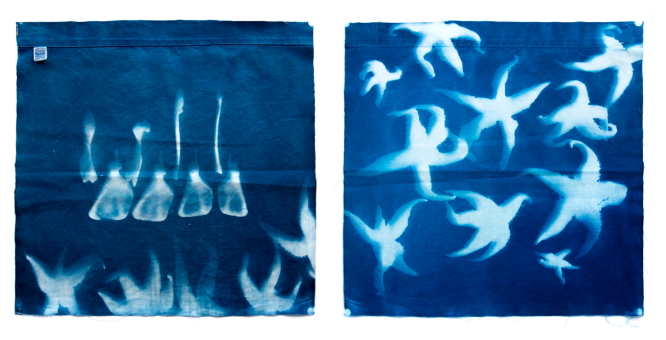
Starfish swarm with wallaby bones by Victoria Cooper
.
STARFISH SWARM WITH WALLABY BONES An artists book by Victoria Cooper
A double-sided cyanotype made from objects gathered in Tasmania. The work was made to celebrate the 2019 World Cyanotype Day.
CREATED: 2019 in Cygnet, Tasmania
MEDIA: Cyanotype on recycled linen pillowcase
SIZE: 30 x 30 cm
EDITION: Unique state
Download a didactic about this book: COOPER-Starfish swarm an wallaby bones
.
.

Roland Barthes an artists book by Doug Spowart
.
ROLAND BARTHES An artists book by Doug Spowart
Roland Barthes the French writer and theorist, has contributed significantly to the discourse and critique of photography. This book is a visual comment on two of his texts.
CREATED: 2017 at Bundanon during an artist in residence
MEDIA: Concertina format with 16 pages, cyanotype on Arches watercolour paper
Binding by Doug Spowart
SIZE: 11 x 14 x .4 cm
EDITION: Two unique states
Download a didactic about this book: Doug SPOWART -Barthes
.
.
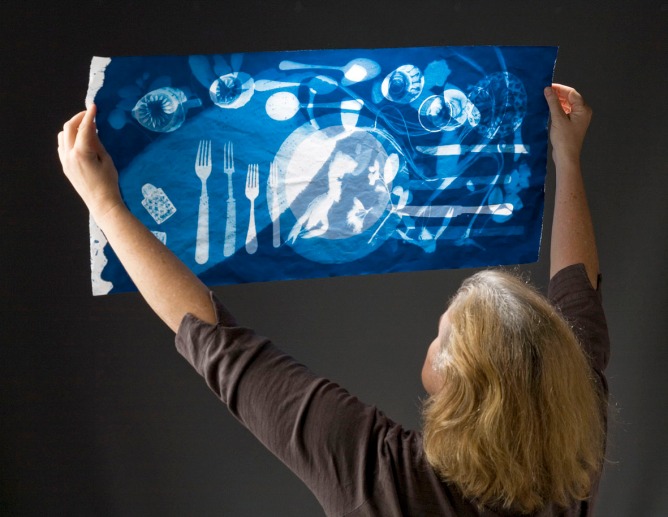
AUSTRALIAN BANQUET: January 26 / 26, 1788 by Cooper+Spowart
.
AUSTRALIAN BANQUET: January 26 / 26, 1788 by Cooper+Spowart
This work reflects on the ‘turning of the page’ in history that Australia Day represents.
CREATED: 2010 on Australia Day in Toowoomba
MEDIA: A unique state double-sided cyanotype on rice paper broadsheet of 7 variants.
SIZE: 37.6 x 77cm
Download a didactic about this book: COOPER+SPOWART – Australian banquet
.
.

PHOTOGRAPHS OF ARTHUR’S GARDEN A book by Doug Spowart
.
PHOTOGRAPHS OF ARTHUR’S GARDEN A book by Doug Spowart
A cyanotype concertina book made on the veranda of Arthur Boyd’s studio during an artist in residence
CREATED: 2007 at Bundanon
MEDIA: 24-sided concertina book. Cyanotype on Arche watercolour paper
SIZE: 11 x 14 x .4 cm – extends to 168 cm
EDITION: Unique state
Download a didactic about this book: SPOWART – Photographs of Arthur’s Garden – extended
..
.
.
.
.
THANKS TO: Lisa Sharkey and the Team for the opportunity to present these works at Hill End Analogue.
The photograph of the HEA installation courtesy of Lisa Sharkey
Text and cyanotype works and photographs © Doug Spowart+Victoria Cooper
.
.
.
.
CYANOTYPE IN AUSTRALIA Celebrates World Cyanotype Day 2020
The world is in a pandemic turmoil but beneath the stress, pain and fear of what some call the ‘new normal’ artists have continued making their art. During this time online connectivity has provided the space to coalesce communities of practice across the world where ideas and creative products can be shared, discussed, recognised and critiqued.
Cyanotypers worldwide celebrated 2020 WORLD CYANOTYPE DAY on the 26th of September by making cyanotypes, presenting work in exhibitions and online through their social media platforms. In the USA there are dedicated groups that have continued to support the medium: Db Dennis Waltrip, Judy & Amy and the World Cyanotype Day web and Facebook group; Malin Fabbri‘s Alternativephotography.com; and Amanda Smith’s Gallery in Texas. These people have created the glue that brings together cyanotypers from around the world.
Two years ago The Cyanotype in Australia Facebook Group was formed to bring together contemporary cyanotype work for presentation in major survey shows to celebrate Australian practioners from across the country on World Cyanotype Day. The first show in 2018, ‘In Anna’s Garden’ was presented at the prestigious Monash Gallery of Art, Melbourne. Last year ‘Under the Southern Sun’ was shown at The Maud Street Photo Gallery – The Queensland Centre for Photography. This exhibition then toured to two venues in the USA: the A. Smith Gallery, Texas, and PhotoNOLA, New Orleans for the international World Cyanotype Day exhibition.
The Cyanotype in Australia Facebook group has actively supported a vibrant community of practice of not only local, but also international cyanotypers. This year, we decided to curate the World Cyanotype Day event online through the Facebook Group page as this space enabled many artists from across Australia and internationally to contribute during these challenging times. We asked our Facebook Group members to select a cyanotype that may have been their first print, an image of a current process investigation or a work that tells a story. Forty-three Australian and a few international Friends responded and posted their work on the page.
This catalogue has now been collated to show the breadth and creative work of these artists. We are again excited to present the amazing work of Australians including our international friends on The Cyanotype in Australia for World Cyanotype Day 2020.
The Cyanotype in Australia Facebook page is a closed group though we welcome ‘Requests to join’ from cyanotype practitioners.
Doug Spowart,
with Gail Neumann, David Symons and Victoria Cooper are The Cyanotype in Australia Team
.
A GALLERY OF WORKS CAN BE SEEN HERE
More information about these works can be found in the catalogue
Download the catalogue via this link ____WCD 2020 CATALOGUE-FINALv4
.
.
Over the last two years the CYANOTYPE IN AUSTRALIA Facebook group has coordinated major events to coincide with this celebration.
In 2018 an exhibition entitled “IN ANNA’s GARDEN” was curated Stephanie Richter, Gillian Jones, Victoria Cooper and Doug Spowart for showing at the Monash Gallery of Art.
A blog post for this exhibition can be viewed HERE
A download of the “In Anna’s Garden” catalogue can be accessed HERE
.
.
2019 saw the assembly of a group of Australian cyanotyper’s works to be sent to the A. Smaith Gallery and Photo in New Orleans for the WCD International exhibition. The cyanotypes were firstly shown in the exhibition “UNDER THE SOUTHERN SUN” at The Maud Street Photo Gallery – The Queensland Centre for Photography.
A blog post for this exhibition can be viewed HERE
A download of “Under the Southern Sun” catalogue can be accessed HERE
.
.
.
.
.
.
A TASMANIAN CYANOTYPE: Untitled Found Objects by Victoria Cooper
 Untitled found objects a cyanotype by Victoria Cooper
Untitled found objects a cyanotype by Victoria Cooper
Untitled Found Objects is created from a collection made of invasive starfish species colonising parts of Tasmanian waters and a map-shaped beer coaster found discarded in the streets of Hobart. In this work I play with these found objects and speculate on their relationship with Place.
.
 Found objects: Starfish and Tasmanian coaster map
Found objects: Starfish and Tasmanian coaster map.
When I take the time to study a place through photography and Material Thinking* history is unearthed, reconsidered and reordered. As I walk in each place, I identify and collect objects for further study. Some objects are commonplace or endemic while others may be discarded or dislocated dissonant interventions. I then utilise the cyanotype process as a site-specific medium to record these collections using sunlight and other environmental conditions as experienced in-situ. In this work the cyanotype forms a blue matrix in which these objects are imaged as their shadows. The shadowy imprints inhabit the blue as white ghostly forms referential of their solid origins.
The final work of blue and white is a paradox between its fiction and truth, the featureless blueness only revealing form by its absence. To think about the cyanotype in this way ushers in many questions: Is the cyanotype blue a political or aesthetic statement? Do the white shadows speak of absence or are they the essence of a presence? Does the reader need an exegesis to understand a poem?i
Victoria Cooper
.
 Untitled found objects exposing the cyanotype
Untitled found objects exposing the cyanotype
*The concept of an aesthetic methodology proposed by Paul Carter in his book, Material Thinking, defines my art, and underpins the making of my work. Through a psychological dialogue with materials, subjects and objects, my work evolves reflexively and in concert with the response to physical experience of time and place. In this process I am taken in new directions and presented with unexpected outcomes for the work.
Just as human collaborators needed to suspend an irritable desire for control of the project, substituting instead a lover’s readiness to be plastically moulded by the other’s (intellectual) desire, so with materials: they self selected, those of especial value to enquiry displaying gifts of amalgamation and self transformation analogous to the emotional environment characteristic of the human exchange. (Carter 2004:xiii)
Paul Carter, 2004, Material Thinking, Melbourne University Publishing Ltd, Melbourne.
.
.
.
.
.
.
©2019 Victoria Cooper
AUSTRALIAN CYANOTYPES on exhibition at home & in the USA
.
For over a year we have been coordinating with Gail Neumann the Facebook group THE CYANOTYPE IN AUSTRALIA. In June of this year we circulated through our networks an Invitation for Australian cyanotypers to submit work for a travelling exhibition to be shown in Brisbane, Australia and then Texas, USA to link with World Cyanotype Day celebrations on September 28, 2019. This work will be first shown at The Maud Street Photo Gallery, Brisbane in August and will then travel to the USA to be part of two international exhibitions, one at the A Smith Gallery, Texas in September, and then at PhotoNola, New Orleans in December.
.
.
THE BRIEF FROM THE INTERNATIONAL WORLD CYANOTYPE EXHIBITION COORDINATORS:
The exhibition theme Land/Sea/Sky with the exhibition abstract being: Most ancient peoples had no word for the color blue. They could not explain the sky nor the ocean. Poetry and love letters suffered. Once “blue” entered the world the earth rattled and chimed, sending forth “turquoise” and “sapphire.” The Navajo and the Jewelers rejoiced. Poets wept. Picasso danced and Policemen beamed. Mary smiled.
It was hoped that everyone in the world making cyanotypes that could be connected with was invited to create the cyanotypes on white cloth, each 12×12 inches (30×30cm) and that they will be strung together, the flags symbolize the beautiful planet we all inhabit.
.
.
CYANOTYPERS FROM OVER AUSTRALIA RESPONDED TO THE CALL-OUT
Here are their images:
THE EXHIBITION AT THE MAUD STREET PHOTO GALLERY
THE CATALOGUE
A catalogue about the Under the southern sun project featuring each submission, artist’s statements and exhibition documents has been collated, the cyanotypes copied and designed by Doug Spowart. The catalogue forward states:
The Cyanotype in Australia is a photographic medium that continues to be enthusiastically utilised by a growing group of creative practitioners ranging from analogue photographers to fine art printmakers.
While the process and the chemical formulas may be the same the resulting images vary depending on the subject chosen and the creative input of the cyanotypist. This is proven by this body of work and the plethora of potential outcomes presented. And sometimes, as with the vagaries of the process, many results may be a surprise to the author at the time the image is washed-out. Such is the nature and the promise of things hand-made.
We are excited to contribute this collection of cyanotype flags to the 2019 World Cyanotype Day Celebrations at the A Smith Gallery in Texas and PhotoNola in New Orleans in the U.S.A.
FREE TO DOWNLOAD HERE: AUSTRALIAN_WCD_CATALOGUE-Final
THE BEHIND THE SCENES
THE CYANOTYPE IN AUSTRALIA Team coordinated:
- A gallery exhibition at The Maud Street Photo Gallery in early August that will include an opening event
- The packaging and shipment of the ‘Flags’ to the USA by the due date
- The creation and distribution of social media content promoting the Australian artworks and their makers
- A PDF catalogue of all contributor’s works
- And later the return of the works to their makers on conclusion of the project.
A fee of $40 was charged to all participants
This project, by The Cyanotype in Australia team, was curated by Gail Neumann, Victoria Cooper + Doug Spowart with assistance from David Symons.
The gallery installation team: Gail Neumann, Victoria Cooper, Irena Prikryl, David Symons and Doug Spowart
.
.
.
BEAUTIFUL FRUIT – Tilley Wood+Linda Spowart
.
A Fruitful Place – a review by Victoria Cooper
Place, of course, as opposed to the more generalized ‘site’ or ‘land,’ is a specific collaboration between nature and people, constantly altered and inevitably defined by narratives from the contact zones.[1]
This exhibition is the result of a collaborative interaction between the artists, the cotoneaster tree and its environment. The intent was to create visual responses to observations of the tree and its rhythms over time that forms:
… a dedication to and recording of this tree. Its life is multifaceted, one that connects to and affects the space and people around it. Its vital and variable presence is what they are drawn to and present here. This exhibition is the fruit of the artists and subject together.
.
Although Linda and Tilley approached the project from two different perspectives both were influenced by the phenomena of light and wind to define the tree, its form and movement. Tilley’s paintings of the tree evoked a poetic place illuminated by memory. Linda’s prints were layered using cyanotype photograms[2] or inks in contact with parts of the tree and its surroundings, then over printed with gesso and drawings were full of detail referencing the visual language of botanical illustration and empirical scientific evidence gathering.
.
.
As part of their investigation, the artists individually and collaboratively created through direct contact with parts of the tree: leaves, fruit and branches, they made more cyanotype photograms. These prints were more like impressions, rather than the detailed recording of scientific photographs. On one wall at the entrance to the main gallery there was an impressive installation of these blue prints creating a feeling for the tree’s blue shadowy and dappled light space.
.
.
The cotoneaster tree was both subject and collaborator in this exhibition. As part of their investigations, the artists attached drawing devices to branches of the tree in order that it would self record its movement without the intervention of the artists’ hand. This is an important methodology for many artists as it opens up an inclusive space where the agency or ‘voice’ of objects and other life-forms as collaborators can present new and surprising perspectives. Australian artist, Cameron Robbins[3], presented the drawings that were formed through devices attached to a windmill to record the movement of the wind around Museum of Old and New Art (MONA), Hobart, Tasmania. Robbins intent was
… to connect to landscape, and to the greater dynamic of the whole climate system; how patterns move through a particular location. For me, that’s the most direct way to access the greater energies and forces around us.’ Cameron Robbins[4]
Art when made in collaboration with both human and non-human entities involves a corporeal, sensate empathy that evolves over time spent in contact within their space and place. These are dynamic contact zones where human and nature interaction can stimulate the development of alternative views and knowledge to bring fresh ways of understanding the changing world we share with Others. Both Tilley and Linda have engaged with the Place that is the tree, not to objectify or imitate, but to wonder, imagine, transform and be transformed.
Dr Victoria Cooper
.
.
NOTES:
[1] Stuart, M & Lippard, L 2010, Michelle Stuart, Sculptural Objects: Journeys In & Out of the Studio, Charta, Milano, page 11.
[2] The Cyanotype process was developed by Sir John Herschel in the 1840’s and at this time 19 th century botanist Anna Atkins used the process to document her plant specimens. The process: water colour paper or cloth is coated with a chemical made by the light sensitive combination of potassium ferricyanide and ferric ammonium citrate. After drying, objects placed on the material and then exposed in sunlight. Ultra-violet light is required and exposure times may be 8-10 minutes although times may vary depending on the time of year – or day. Many photographer also expose enlarged contact negatives of photographs onto the cyanotype emulsion.
[3] Cameron Robbins, Field Lines, MONA see https://mona.net.au/museum/exhibitions/past-exhibitions/cameron-robbins-field-lines
[4] ibid. an in-text quote from the article by the curators, Nicole Durling and Olivier Varenne
.
.
.
.
.
.
MAKING BLUEPRINTS TODAY–Our World Cyanotype Day Australian Submission
.
Making cyanotypes in Tasmania
We created some cyanotypes yesterday to contribute to the Australian World Cyanotype Day (WCD) travelling exhibition. Setting up a coating studio inside a friend’s house in Cygnet Tasmania we exposed the sensitised material on the front veranda and washed-out on the shadow side of the house. It all sounds rather an impromptu affair and in some ways it is, as travelling artists we have encountered these challenges before making-do with the site-specific needs of each art-making opportunity.
But what is difficult in Tasmania right now is the weather. We’ve been ready for weeks to make cyanotypes and yet the pervading conditions have been overcast or scattered heavy clouds between sunny gaps, rain or fog. And as cyanotypes work best with clear, bright and directly overhead sunlight it has been difficult. Added to this mid-winter’s low angle of sunlight at 43°south means exposure times have to be extended 3-4 times that commonly achievable up the east coast of Australia.
Making cyanotypes is a process that takes place over time. Chemicals are mixed, the substrate coated with a brush. On this occasion we were printing on cloth and due to the ‘flow-through’ the material we coated a few sheets sitting on top of each other. These super wet sheets then needs to dry. Cloth takes quite a while to dry due to the large amount of chemical absorbed in the fibers although drying can be accelerated by using a blow heater or hair dryer.
.
Coating the material…
.
.
Next a series of test exposures may need to take place to know, in the specific sunlight conditions you may be working in. After exposure the material is washed-out in running water – we add a little citric acid. And for an accurate density check the sheet needs to be dried a little. Then you can make your first exposure. At the moment in Tassie we’ve been working with 15 minute exposures!!
All this means that you may start out with sunny skies, do your tests and then start you exposure and the clouds come in – the Bureau of Meteorology website is regularly monitored to make sure that you have an adequate time over which to work.
.
Making the exposure…
.
Washing out after exposure…
.
.
Finally it’s hung up to dry …
.
Vicky’s work is a response to contemporary land and sea issues in Tasmania. The image is a double-sided cyanotype – shown here is the transparency of the work with the blending of the two images.
.
Doug’s cyanotype continued his experiments in direct light-strike on cyanotype sensitised materials. On this occasion the folding and refolding over the duration of the exposure creates a pattern of different blue densities. These emulate, like colour swatches, the different hues and tints of blue in the Tasmanian landscape. This is also a double-sided cyanotype that in this photo is still quite wet and yet to dry down.
Both cyanotypes have been made on linen material and are about 30 centimetres square. The linen was purchased at a local charity shop as second-hand white pillowslips. The A Smith Gallery presentation of these fabric squares has them pegged to lines running across the gallery ceiling where they appear like flags.
.
.
The cyanotypes that we have made will be included in an exhibition of Australian cyanotypers at The Maud Street Photo Gallery in Brisbane during August 2-15. The exhibition is being co-curated by The Cyanotype in Australia team Gail Neumann and us (Vicky+Doug), and will bring together works from all over the country. It is a follow-up exhibition to the WCD exhibition ‘In Anna’s Garden’ curated by Stephanie Richter, Gillian Jones and us at Monash Gallery of Art last year.
.
.
This year’s show is entitled ‘Land/Sea/Sky’ and the show at The Maud Street Photo Gallery is just the beginning as the works will be forwarded to the A Smith Gallery in Johnson City Texas for showing on World Cyanotype Day along with other works from across the world. At the end of the A Smith Gallery show the works will be sent on for exhibition in New Orleans at the PhotoNOLA Festival.
Participants in the exhibition will make a contribution to the costs of the Maud show as well as courier delivery to the U.S.A. and back home to Australia.
AN INVITATION TO ALL AUSTRALIAN CYANOTYPERS
An invitation has gone out through various networks inviting cyanotype makers to participate in the Australian WCD Travelling exhibition. If you make cyanotypes please consider being a contributor to the show. If know someone who does please let them know about the exhibition and pass on to them the AUST_WCD_SUBMISSION.
.
For information about The Cyanotype in Australia and to join the the group’s FACEBOOK page: CLICK HERE
.
To Download a PDF copy of the catalogue for the MGA exhibition click the link: In_Anna’s_Garden-CATALOGUE-FINAL-INT
.
,
1788–January 25th, the next day, and now
In 2010 we wanted to make an artwork to comment and reflect on Australia Day and some of our feelings about the origins of the date – the implications of that event and the repercussions that we live with and navigate today. Through a scorchingly hot day in Toowoomba we worked with cyanotype solutions and selected objects – some from our home and others sourced from the food scraps from a local seafood smorgasbord restaurant on the day.
The work that we did that day emerged as the collaborative artists’ book, a broadsheet we titled, Australian Banquet, January 25/ 26, 1788.
A statement about the artwork
Across Australia over the January 26th long weekend, people prepare, cook and consume food to mark this day in history.
For us, this work is our response to, and in recognition of, the ‘turning of the page’ in Australian history that this date represents. One day, January 25th 1788, Aboriginal people feasted on a diverse banquet of bush tucker as they had for thousands of years. The next day, the country was transformed by a new paradigm represented in this work by the table setting of the First Fleet.
Australia Day, for us, is an important time to acknowledge the First Peoples’ perspective and their knowing of land, culture and history and how it should be recognised as underpinning the diversity and identity of contemporary Australia. We, as descendants of European people, are seeking to understand and know more about our place within the longer history of this land.
.
The 25th of January side of the broadsheet is viewed and contemplated.
.
The broadsheet is then turned over to view the 26th of January side.
.
Finally the broadsheet is held up to the light – the complex interrelationship between the two visual references to be seen and considered.
BOOK DESCRIPTION: A unique state artists’ book broadsheet
TITLE: Australian Banquet January 25/26, 1788
MEDIA: Double-sided cyanotype image in rice paper
DIMENSIONS: 37.6 x 77cm
PLACE & DATE MADE: Toowoomba, Queensland, Australia, 2010
EDITION: 7 variations
EXHIBITIONS & AWARDS:
2015 EXHIBITED: Books by Artists, The Webb Gallery as part of the Artists Book Brisbane Event, Conference at the Queensland College of Art, Brisbane
2014 EXHIBITED: Alternative Imaging – Curated by Dawne Fahey at Two Doors Gallery, The Rocks, Sydney
2011 SHORTLISTED: Southern Cross University Artists’ Book Award, Lismore. Judge: Ross Woodrow
2011 EXHIBITED: BLUE – Arts Council Toowoomba members exhibition, Toowoomba Regional Art Gallery
2010 FINALIST: Josephine Ulrick & Win Schubert Photography Award,
………………………Gold Coast City Gallery. Judge: Judy Annear
COLLECTIONS: Australian Library of Art, State Library of Queensland
.
.
.
.
.
.
.
..
.
.
.
.
.

.
.
.
.
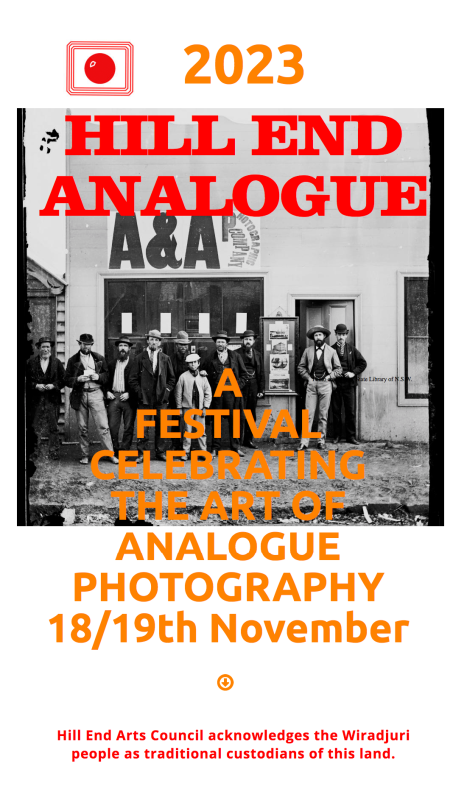


























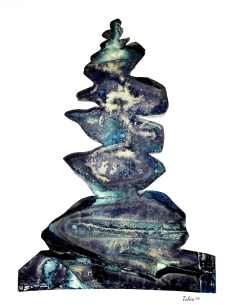






























































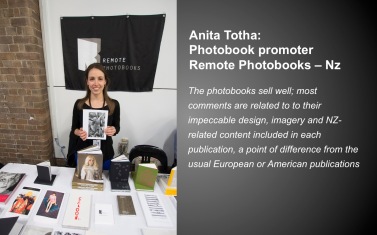





























































































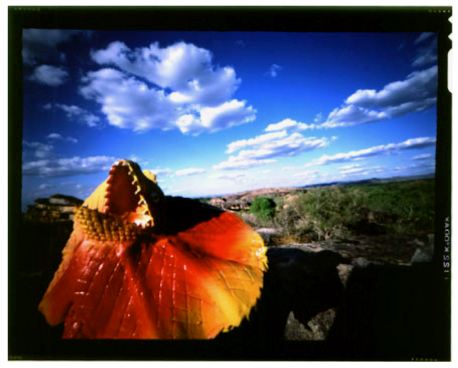


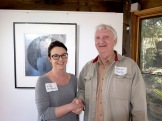




















































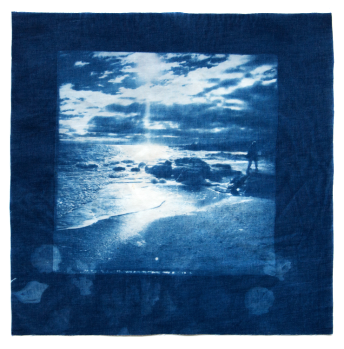


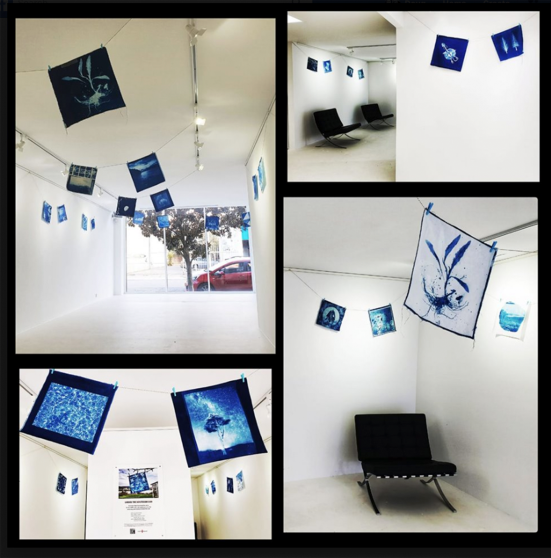



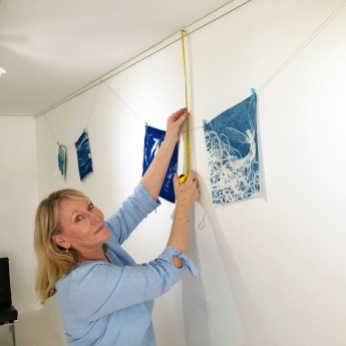
























BRITISH LIBRARY Acquires our cyanotype artists’ book
with 5 comments
A statement about the artwork
Across Australia over the January 26th long weekend, people prepare, cook and consume food to mark this day in history.
For us, this work is our response to, and in recognition of, the ‘turning of the page’ in Australian history that this date represents. One day, January 25th 1788, Aboriginal people feasted on a diverse banquet of bush tucker as they had for thousands of years. The next day, the country was transformed by a new paradigm represented in this work by the table setting of the First Fleet.
Australia Day, for us, is an important time to acknowledge the First Peoples’ perspective and their knowing of land, culture and history and how it should be recognised as underpinning the diversity and identity of contemporary Australia. We, as descendants of European people, are seeking to understand and know more about our place within the longer history of this land.
.
View 1: Australian Banquet, January 25/ 26, 1788
The 25th of January side of the broadsheet is viewed and contemplated.
.
View 2: Australian Banquet, January 25/ 26, 1788
The broadsheet is then turned over to view the 26th of January side.
.
View 3: Australian Banquet, January 25/ 26, 1788
Finally the broadsheet is held up to the light – the complex interrelationship between the two visual references to be seen and considered.
BOOK DESCRIPTION: A unique state artists’ book broadsheet
TITLE: Australian Banquet January 25/26, 1788
MEDIA: Double-sided cyanotype image in rice paper
DIMENSIONS: 37.6 x 77cm
PLACE & DATE MADE: Toowoomba, Queensland, Australia, 2010
EDITION: 7 unique state variants
SOME REFLECTIONS ON THE BOOK’S HISTORY
COLLECTIONS, EXHIBITIONS & AWARDS:
2020 COLLECTION: British Library
2015 EXHIBITED: Books by Artists – The Webb Gallery as part of the Artists Book Brisbane Event, Conference at the Queensland College of Art, Brisbane
2014 EXHIBITED: Artist’s Books (reprised) [artists’ books 1978-2014] – George Paton Gallery, University of Melbourne
2014 EXHIBITED: Alternative Imaging – Curated by Dawne Fahey at Two Doors Gallery, The Rocks, Sydney
2011: COLLECTION: Australian Library of Art, State Library of Queensland
2011 SHORTLISTED: Southern Cross University Artists’ Book Award, Lismore. Judge: Ross Woodrow
2011 EXHIBITED: BLUE – Arts Council Toowoomba members exhibition, Toowoomba Regional Art Gallery
2010 AWARD WINNER: Martin Hanson Awards, Gladstone Regional Art Gallery – Works on Paper
2010 EXHIBITED: Art Bound – Red Gallery, Glebe, Sydney
2010 FINALIST: Josephine Ulrick & Win Schubert Photography Award – Gold Coast City Gallery. Judge: Judy Annear
.
.
.
.
.
Text and © Doug Spowart+Victoria Cooper
.
.
.
.
Share this:
Written by Cooper+Spowart
January 26, 2020 at 1:20 pm
Posted in Artists Books, Cyanotypes, Wot happened on this day
Tagged with 1788, artists' book cyanotype, Australia Day comment, Australia Day in art, colonial Australia, cyanotype, Helen Cole, invasion day, January 25/ 26, View 1: Australian Banquet